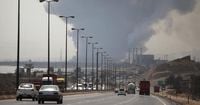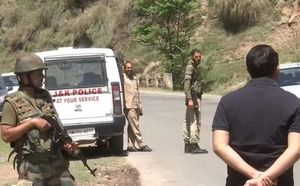A massive explosion rocked Shahid Rajaee Port in Bandar Abbas, southern Iran, on Saturday, April 26, 2025, resulting in at least five fatalities and injuring over 700 individuals, according to state media reports. The blast, which is believed to have been caused by the explosion of chemical materials stored at the port, sent shockwaves throughout the region, shattering windows and causing damage several kilometers away.
The incident occurred during a critical time as Iran engaged in a third round of nuclear negotiations with the United States in Oman. However, there is currently no indication that the explosion is linked to these diplomatic talks.
Initial reports indicated that the explosion may have originated from a shipment of sodium perchlorate rocket fuel, a chemical ingredient associated with missile propellant. This shipment had reportedly arrived at the port in March 2025, raising concerns about the handling of hazardous materials in the area. Hossein Zafari, a spokesperson for Iran's crisis management organization, stated, "The cause of the explosion was the chemicals inside the containers," emphasizing that poor storage practices may have contributed to the disaster.
Videos circulating on social media depict a massive cloud of black smoke billowing into the sky, while emergency responders rushed to the scene to evacuate the injured and extinguish fires. Local officials confirmed that the port's customs office was involved in the response efforts, which included evacuating trucks from the vicinity of the explosion.
Mehrdad Hassanzadeh, head of Hormozgan province’s crisis management authority, reported that the explosion resulted from several containers stored in the port’s wharf area. He noted, "We are currently evacuating and transporting the injured to nearby medical centers." The explosion has prompted the suspension of all port activities as authorities work to assess the damage and ensure safety.
The Shahid Rajaee Port is a crucial facility for container shipments, handling approximately 80 million tons of goods annually. It is strategically located on the Strait of Hormuz, a vital waterway through which about 20% of global oil trade passes. The port’s significance in regional trade highlights the potential economic repercussions of this incident.
In the aftermath of the explosion, Iranian state television reported that the blast was so powerful it could be felt and heard up to 50 kilometers away. Residents in nearby towns described feeling the ground shake from the force of the explosion, which shattered windows and caused structural damage to buildings.
Authorities have faced criticism in the past for industrial accidents, particularly those involving aging energy infrastructure that struggles to secure parts due to international sanctions. This incident adds to a troubling history of negligence in Iran’s industrial sector, which has seen a series of deadly accidents over the years.
In 2023, a separate incident at the port resulted in the death of a worker during emergency repairs, highlighting ongoing safety issues. Moreover, in 2020, Shahid Rajaee Port was targeted by a cyberattack attributed to Israel, which raised questions about the security of Iran's critical infrastructure.
The Iranian government has not yet commented on the potential involvement of external actors in the explosion, although Israel has previously been accused of conducting operations to undermine Iran’s military capabilities. Reports suggest that Israel is particularly concerned about Iran's missile program, which it sees as a direct threat. However, there has been no immediate response from Israeli officials regarding the Saturday explosion.
As the situation continues to unfold, Iranian authorities are conducting investigations to determine the exact cause of the explosion and the extent of the damage. The National Iranian Oil Refining and Distribution Company has confirmed that the blast did not impact any refineries, fuel tanks, or oil pipelines, stating that operations remain unaffected.
The explosion at Shahid Rajaee Port serves as a stark reminder of the dangers associated with the handling of hazardous materials, especially in a country with a history of industrial accidents. As emergency services work to manage the aftermath, the focus remains on ensuring the safety of workers and preventing future incidents.
In light of this disaster, Iranian officials are calling for a thorough review of safety protocols at the port. The tragic events of April 26, 2025, may prompt a reevaluation of how hazardous materials are stored and managed in Iran’s industrial sectors, particularly in facilities as critical as Shahid Rajaee Port.





